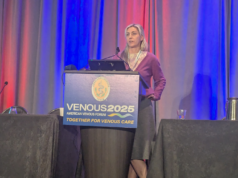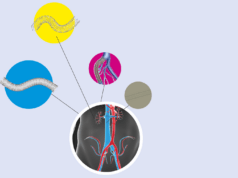
For many venous specialists, dedicated venous stents represent the future—and the promise of an ideal venous stent on the horizon is a central topic of discussion. In this article, Rick de Graaf reviews the recent history of venous stenting and outlines the questions that need to come next.
Obviously, treatment of deep venous obstructions with stents goes much further back than just five years. The first reports of successful deep venous stenting originate from Germany, Sweden and the USA in the early 1990s. Mainstream attention increased rapidly in the early 2000s, after publications by the Stanford group (O’Sullivan and Dake) and of the best-known series by Neglen and Raju.
Nevertheless, the last five years may truly qualify as a new era. Deep venous interventions blossomed intensely during this time, with multiple centres in Europe and the USA exploring interest in the endovascular approach. Both physicians and industry sought new innovative techniques and devices and thus, dedicated venous stents were developed. Deep venous treatment became a returning popular theme at major conferences around the world. Thereby, discussions over approach, strategy and devices intensified with a host of questions: Which imaging modality should be used? Is any stent superior over others? Do we need recanalisation devices? Which patient does well after recanalisation and which patient does not? How do we identify the optimal patient for intervention? Why do stents reocclude and how do we prevent it? What is the best antithrombotic strategy—anticoagulation, antiplatelets or both; and how much is needed, how long for, etc. The list goes on and on.
A few major points should be discussed, in order to shed light on the current state of venous stenting procedures. The first dedicated stents came to the market around 2012. At the time, the Wallstent was not considered good enough. Admittedly, the Wallstent caused some problems—in my own experience as well—and some were difficult to solve. Nevertheless, since 2012, I have not seen a perfect stent appear. Every stent has specific pros and cons. Some downsides are so destructive however, that the problems caused by the stent cannot be solved anymore, at least not through endovascular means. Sometimes, it even feels like a step backwards.
Although newer stents may be easier to deploy and can be positioned more accurately, it is important to note that there is no scientific evidence that any of the new stents perform better than the Wallstent. Certainly, new stents will continue to enter the market in the coming years, some with well thoughtout designs that may help to boost clinical success, others with anti-proliferating drug coatings or another unsubstantiated smart marketing gimmick. Still, these stents should not be expected to magically shift the patency to 100%.
Naturally, this does not mean we should not continue to look for innovations to support our daily practice and optimise patient outcome. However, if stent design does not fully account for stent patency, what does? As can be extracted from Virchow’s triad, unfavourable haemodynamics or increased coagulability may be additional reasons for stent occlusion. Low flow may cause thrombosis, but we do not know how much flow is enough. I have seen some patients with dreadful flow with patent stents after many years, while others have excellent flow yet still occlude.
Although the need of antithrombotic therapy after deep venous stenting is beyond discussion, the exact concentration, duration and type remain debatable. Direct anticoagulants (DOACs) seem to slowly but surely be surpassing vitamin K-antagonists as primary oral anticoagulants (OACs); however, some interventionalists challenge the superiority of OAC in favour of antiplatelets. Due to the multifactorial nature of stent reocclusions, it will be extremely hard if not undoable to find superiority of one medical treatment over the other. It is important however to scrutinise the optimal antithrombotic strategy for the individual patient. Attention for resistance to certain medications should also be advocated for deep venous interventions; close collaboration with haematologists therefore is recommended. Stent reocclusion is cumbersome to treat and increases the risk of (fatal) pulmonary emboli.
The deal may not be sealed with an open stent however. Why do some patients benefit from an open stent while others seem not to improve? For one, the complaints may not have been venous-related in the first place. So, do we need better or different scoring systems? Although the Villalta scale is most widely used, it has not been published in a peer-reviewed journal and is open for critique. Another reason may be inadequate venous outflow from the leg, either by continued venous insufficiency due to valve destruction or absence of inline flow towards the stents. Previously created collateral pathways may inadequately distribute a significant blood volume away from the stented venous segments. Thus, patent iliac stents do not necessarily prevent venous hypertension in the leg. Maximising complete and fast outflow of the leg into the stents is the prerequisite.
Finally, some patients may not qualify for treatment in the first place. Patient selection should be one of the key points of interest. Extensive post-thrombotic scarring of all major inflow veins may preclude autonomous long-term stent patency. Surely, an arteriovenous fistula can be placed in all of these patients. The stents are likely to stay open—that is, until restenosis by intimal hyperplasia. However, when spontaneous venous blood flow from the leg is compromised it is unlikely that the patient will do better.
In conclusion, the last five years established the bottlenecks of a procedure that nevertheless has proved very successful and safe. Optimisation of antithrombotic therapy and flow enhancement may result in the unchallenged status of deep venous stenting.
Rick de Graaf is director of Radiology, Interventional Radiology and Nuclear Medicine at the Clinical Centre of Friedrichshafen, Germany









